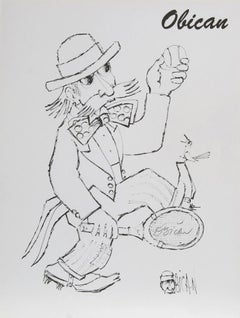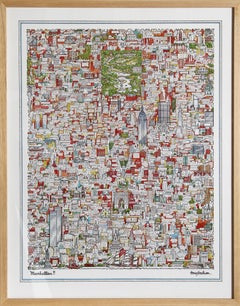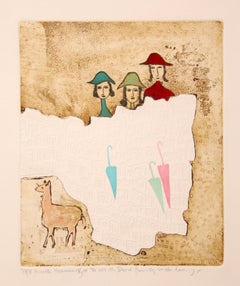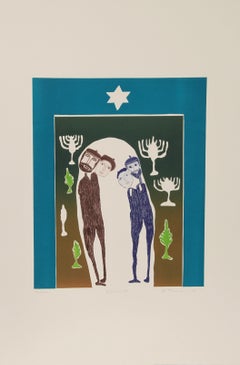Want more images or videos?
Request additional images or videos from the seller
1 of 6
Manhattan!!1978
1978
Price:$600
About the Item
About the Seller
4.9
Platinum Seller
Premium sellers with a 4.7+ rating and 24-hour response times
Established in 1979
1stDibs seller since 2014
3,162 sales on 1stDibs
Typical response time: 1 hour
Authenticity Guarantee
In the unlikely event there’s an issue with an item’s authenticity, contact us within 1 year for a full refund. DetailsMoney-Back Guarantee
If your item is not as described, is damaged in transit, or does not arrive, contact us within 7 days for a full refund. Details24-Hour Cancellation
You have a 24-hour grace period in which to reconsider your purchase, with no questions asked.Vetted Professional Sellers
Our world-class sellers must adhere to strict standards for service and quality, maintaining the integrity of our listings.Price-Match Guarantee
If you find that a seller listed the same item for a lower price elsewhere, we’ll match it.Trusted Global Delivery
Our best-in-class carrier network provides specialized shipping options worldwide, including custom delivery.You May Also Like
Indian Summer in Nantuckett
By Jane Wooster Scott
Located in San Francisco, CA
This artwork titled "Indian Summer in Nantuckett" is an original offset lithograph on wove paper by American artist Jane Wooster Scott, born 1933. It is hand signed and numbered 681/750 in pencil by the artist. The image size is 27 x 20 inches, framed size is 39 x 32.25 inches. It is beautifully framed in a custom wood frame. It is in excellent condition.
About the artist.
Jane Wooster Scott grew up in the Philadelphia area and moved West following her dream to be a movie star. She quickly learned that goal was not for her, but became the host of a talk show where she interviewed movie stars.
She photographs what she sees to recapture them later on canvas. However, few of her paintings are real, existing scenes. They are compositions drawn from her personal imagination. She has been exhibiting her work in Los Angeles and New York and most of her shows have completely sold out on opening night.
In the "Guinness Book of Records" as one of the most reproduced artists in America, Jane Wooster Scott began copying work by folk artists such as Grandma Moses and gradually evolved into her own style. A turning point for her career was a joint showing at the Ankrum Gallery in Los Angeles with her comedian friend, Jonathan Winters. It was mostly a business crowd, and she sold 40 paintings in an hour.
Her works hang in museums, in public buildings and private homes in Europe, Asia and South America as well as in the United States. She has become legendary for her exceptional scenes of America s celebrations and holidays,
Among her collectors are Aaron Spelling, Sylvester Stallone, Charles Bronson, Kenny Rogers, Farah...
Category
Late 20th Century Folk Art Figurative Prints
Materials
Offset
Natasha Sleeping - Sleeping Beauty Series
By Paul Humphrey
Located in Branford, CT
PAUL HUMPHREY 1931 - 1999
Paul Humphrey was born in Poultney, Vermont, and remained a life-long Vermont resident, moving to Brattleboro, Vermont, in 1971 to work as a house painter ...
Category
21st Century and Contemporary Outsider Art Mixed Media
Materials
Adhesive, Permanent Marker, Carbon Pigment
Karen Sleeping - Sleeping Beauty Series
By Paul Humphrey
Located in Branford, CT
PAUL HUMPHREY 1931 - 1999
Paul Humphrey was born in Poultney, Vermont, and remained a life-long Vermont resident, moving to Brattleboro, Vermont, in 1971 to work as a house painter ...
Category
21st Century and Contemporary Outsider Art Mixed Media
Materials
Adhesive, Permanent Marker, Carbon Pigment
Blue Collograph with Horns
Located in Washington, DC
Appealing collograph Intaglio work by Noche Crist (1909- 2004). Unsigned from the 1970s but one of a kind and handprinted by the artist on thick paper. Catalogue of a postumous retr...
Category
1970s Folk Art Figurative Prints
Materials
Intaglio
"Sitting Bull Goes To Washington"
Located in Washington, DC
Silkscreen work by Noche Crist (1909- 2004). Work is from from her "Sitting Bull Goes to Washington" series. Marked in pencil 15/18 lower left. Printed in 1976 by the artist. Catalo...
Category
1970s Outsider Art Figurative Prints
Materials
Paper
Daybed Daydream
By Hector Ruiz
Located in Phoenix, AZ
copper etching with aquatint
The power of memory and how it recalls individuality begins in such basic experiences as the ability to link internal ideas to external manifestations of those ideas. Memories as simple as an old toy or a street can set off a chain reaction of thoughts that snowball into issues as broad as nationalism, identity politics or a body politic to name a few. Hector Ruiz’s works encompass the broad, complex and often painful world particular to the Arizona and neighboring Mexican landscape. United States and Mexican border...
Category
Early 2000s Outsider Art Figurative Prints
Materials
Copper
Meeting. Paper, linocut, 21x27, 5 cm
By Dainis Rozkalns
Located in Riga, LV
Meeting. Paper, linocut, 21x27,5 cm
imprint size 13,5x20 cm total page size 21x27,5cm
Dainis Rozkalns (1928 - 2018)
Artist, graphic artist, illustrator of folklore and fiction publ...
Category
1970s Folk Art More Prints
Materials
Paper, Linocut
Carnival. 1984. Paper, linocut, 20x34 cm
By Dainis Rozkalns
Located in Riga, LV
Carnival. 1984. Paper, linocut, 20x34 cm
imprint size 10x25 cm total page size 20x34cm
Dainis Rozkalns (1928 - 2018)
Artist, graphic artist, illustrator of folklore and fiction pub...
Category
1980s Folk Art Figurative Prints
Materials
Paper, Linocut
$183 Sale Price
20% Off
H 7.88 in W 13.39 in
Snow day. 1984. Paper, linocut, 25x34 cm
By Dainis Rozkalns
Located in Riga, LV
Snow day. 1984. Paper, linocut, 25x34 cm
imprint size 14x25,5 cm total page size 25x34cm
Dainis Rozkalns (1928 - 2018)
Artist, graphic artist, illustrator of folklore and fiction p...
Category
1980s Folk Art Figurative Prints
Materials
Paper, Linocut
$183 Sale Price
20% Off
H 9.85 in W 13.39 in
Calm sea. Paper, linocut, 26, 5x32 cm
By Dainis Rozkalns
Located in Riga, LV
Calm sea. Paper, linocut, 26,5x32 cm
imprint size 13x20 cm total page size 26,5x32cm
Dainis Rozkalns (1928 - 2018)
Artist, graphic artist, illustrator of folklore and fiction publi...
Category
1970s Folk Art More Prints
Materials
Paper, Linocut
More From This Seller
View AllTennis Player, Folk Art Poster by Jovan Obican
By Jovan Obican
Located in Long Island City, NY
Jovan Obican, French/Yugoslavian (1918 - 1986) - Tennis Player, Year: circa 1995, Medium: Poster, signed, Size: 22 in. x 17 in. (55.88 cm x 43.18 cm)
Category
1990s Folk Art Figurative Prints
Materials
Offset
Manhattan!!, Pop Art Poster by Tony Graham
Located in Long Island City, NY
Tony Graham is a graphic artist known for his drawings and prints of New York City. “Manhattan” is the artist’s most iconic and collectible image published in 1978. Nicely framed.
M...
Category
1970s Folk Art Figurative Prints
Materials
Offset
Rain Storm, Folk Art Aquatint Etching by Mireille Kramer
Located in Long Island City, NY
Mireille Kramer, Egyptian/American (1932 - ) - Rain Storm, Year: circa 1980, Medium: Aquatint Etching, signed and numbered in pencil, Edition: 73/75, Size: 22 in. x 15 in. (55.88...
Category
1980s Folk Art Figurative Prints
Materials
Etching, Aquatint
Biblical III, Folk Art Etching by Mireille Kramer
Located in Long Island City, NY
Mireille Kramer, Egyptian/American (1932 - ) - Biblical III, Year: circa 1980, Medium: Etching, Signed, Titled and Numbered in Pencil, Edition: 300, Image Size: 17 x 14 inches, S...
Category
1980s Folk Art Figurative Prints
Materials
Etching
Egyptian Theme 2, Folk Art Aquatint Etching by Mireille Kramer
Located in Long Island City, NY
Mireille Kramer, Egyptian/American (1932 - ) - Egyptian Theme 2, Year: circa 1980, Medium: Aquatint Etching, signed and numbered in pencil, Edition: 150, Image Size: 6 x 3.5 inch...
Category
1980s Folk Art Figurative Prints
Materials
Etching, Aquatint
Egyptian Theme 1, Folk Art Aquatint Etching by Mireille Kramer
Located in Long Island City, NY
Mireille Kramer, Egyptian/American (1932 - ) - Egyptian Theme 1, Year: circa 1980, Medium: Aquatint Etching, signed and numbered in pencil, Edition: 150, AP, Image Size: 6 x 3.5 ...
Category
1980s Folk Art Figurative Prints
Materials
Etching, Aquatint



